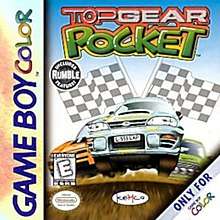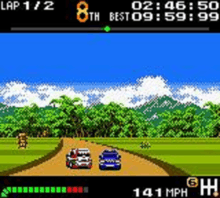Top Gear Pocket
Top Gear Pocket,[lower-alpha 1] known in Europe as Top Gear Rally, is a racing video game developed by Kemco and released for the Game Boy Color handheld console in 1999. A sequel, Top Gear Pocket 2, was released in 2000.
| Top Gear Pocket | |
|---|---|
 North American box art | |
| Developer(s) | Vision Works |
| Publisher(s) | |
| Series | Top Gear |
| Platform(s) | Game Boy Color |
| Release | |
| Genre(s) | Racing |
| Mode(s) | Single-player, multiplayer |
Gameplay

Top Gear Pocket is racing video game where the player drives rally cars through a series of tracks. As the player wins races, new cars and tracks are unlocked.[1] The game features a total of 14 cars and eight tracks.[2] Races can take place in cities, savannas, grasslands, and snowy trails.[2] Both two-wheeled and four-wheeled cars are featured in the game and the handling of each car varies signifficantly.[2] The game cartridge features a built-in rumble feature that vibrates when the player crashes into other cars or slides on the track,[1] but does not feature a battery to save the game progress, so passwords must be used to restore the game to a specific state.[2] The game also includes a multiplayer mode where two players can race against each other.[2] The Game Link Cable is required for multiplayer.[3]
Release and reception
| Reception | ||||||||||||||||||||||||||||
|---|---|---|---|---|---|---|---|---|---|---|---|---|---|---|---|---|---|---|---|---|---|---|---|---|---|---|---|---|
| ||||||||||||||||||||||||||||
Top Gear Pocket was the first Game Boy Color game to introduce a rumble feature in North America.[3] In Europe, the game was released as Top Gear Rally.[8][9] Critical reception for the game was generally mixed.[4] N64 Magazine criticized it for its lack of challenge and variety, stating that tracks are "either a mixture of looooong straights or fairly simple curves", but highlighted its graphics and sense of speed.[8] In contrast, Computer and Video Games felt that the game was very challenging, stating that players might get both "frustration and joy in equal measure."[5] IGN remarked that the graphics are sharp and clear and that the game "creates a very realistic feeling of movement".[2]
The French video game magazine Consoles + praised the game's rumble feature, stating that it enhances the gameplay experience significantly.[9] The Spanish official Nintendo magazine Nintendo Acción agreed, but criticized the car handling and their small size.[10]
References
- Notes
- Citation
- Woods, Nick. "Top Gear Pocket - Review". AllGame. Archived from the original on November 16, 2014. Retrieved May 25, 2017.
- Jones, Tim (June 11, 1999). "Top Gear Pocket". IGN. Archived from the original on December 12, 2016. Retrieved May 25, 2017.
- "Top Gear Pocket". Nintendo Power. No. 120. May 1999. p. 129.
- "Top Gear Pocket". GameRankings. Archived from the original on January 28, 2019. Retrieved May 25, 2017.
- "Top Gear Rally". Computer and Video Games. No. 212. EMAP. July 1999. p. 41.
- "Top Gear Pocket". Game Informer. No. 73. May 1999.
- Davis, Cameron (January 28, 2000). "Top Gear Pocket Review". GameSpot. Archived from the original on June 30, 2019. Retrieved May 25, 2017.
- "Top Gear Rally". N64 Magazine. No. 30. July 1999. p. 39.
- "Top Gear Rally". Consoles + (in French). No. 89. M.E.R.7. June 1999. p. 140.
- "Top Gear Rally". Nintendo Acción (in Spanish). No. 81. Hobby Press. August 1999. p. 59.